Magazine “Russkaya Galereya - XXI Vek” (The Russian Gallery – XXI Century), № 2, 2012
The original article (pdf file)


2012 marks the 100th anniversary of Aleksandr Pavlovich Kibalnikov, People’s Artist of the USSR, full-fledged member of the Academy of Arts of the USSSR, State Prizes Laureate, and outstanding Russian sculptor.
Aleksondr Povtovich Kibalnikov was a master whose creations reveal the epoch's portrait reflecting dramatic pages and images of our history - everything Russia is rightfully proud of today as well. He Is the author of monuments to Vladimir Mayakovsky at Triumphalnaya Square and Pavel Mikhailovich Tretyakov in front of the State Tretyakov Gallery in Moscow. Nickolay Chemyshevsky and Aleksandr Radishchev in Saratov, and Sergey Yesenin in Ryazan. He also directed the project and created central figures («The Soldier» and «Thirst») of the memorial «To the Brest Fortress Defenders».
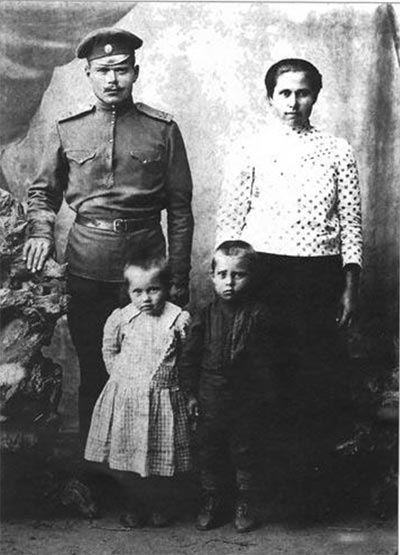
Little Sasha Kibalnikov with his parents and sister. 1918
He was bom into a family of peasants In the village of Orekhovo on the Medveditsa River on August 22. 1912.
From 1929 to 1933 he studied at Saratov Art School.
From 1934 to 1937 he worked as an independent art contractor and served in the army.
From 1938 to 1939 he worked for Kursk Theatre of Drama.
In 1940 he won the second prize of the first round of a competition designed to select a contractor for monuments to N.G. Chemyshevsky in Leningrad and Saratov.
From 1941 to 1945 he lived and worked In Saratov. He is a holder of «The Valorous Work during the Great Patriotic War» Medal.
In 1946 he created «The Undefeated» Sculpture and won the second Republican Prize at a competition in Moscow. In 1946 he also worked over N.G. Chemyshevsky's portrait.
In 1947 he made his «Awakening» sculpture.
In 1948 he completed his portrait bust of A.N. Radishchev and worked over N.G. Chernyshevsky's image.
In 1949 he won the State USSR Prize for a statue to N.G. Chemyshevsky at an All-Union Art Show. In 1949 he also moved to Moscow.
In 1951 he won the State USSR Prize tor a statue to J.V. Stalin at an All-Union Art Show.
In 1953 he unveiled his monument to N.G. Chernyshevsky in Saratov, created a half-figure portrait of A.N. Radishchev, and started working over V.V. Mayakovsky's image.
in 1955 he was elected a full-fledged member of the Academy of Arts of the USSR. In the same year he completed a multifigured monument «To Heroes. Warriors of Krasny Tsaritsyn» in Volgograd, went on creative trips to Hungary and Romania, and got acquainted with K. Baba.
In 1956 he created a portrait of V.V. Mayakovsky, won a long-lasting competition for a project of the poet's monument in Moscow, and went on a creative trip to Italy.
In 1957 he created a monument to V.V. Moyakovsky at the poet's grave in Novodevichye Graveyard and a project of two figures including «To the Sun!» and «To Space!»
In 1958 he won a Bronze Medal of the International Art Show in Brussels for a sculptural portrait of V.V. Mayakovsky and unveiled a monument to V.V. Mayakovsky In Moscow.
In 1959 he was awarded Lenin Prize for a monument to V.V. Mayakovsky.
In 1961 he made wrought copper «Science» and «Progress» figures four meters large for Zvyozdny Gorodok, saw his «To the sun!» bronze figure being erected in front of a United Nations Organization's office in Geneva, and made a sculptural portrait of P.M. Tretyakov.
In 1963 he was awarded the titles ot People's Artist of the RSFSR and People's Artist of the USSR.
In 1965 he created a marble portrait of V.V. Mayakovsky which was eventually erected at Mayakovskaya Metro Station in Moscow.
From 1961 to 1979 he worked over monuments to Lenin to be erected in Saratov, Yelabuga. and other cities.
In 1968 he worked over the memorial «To the Brest Fortress Defenders».
In 1969 he went on a creative trip to France.
In 1970 he was elected an Honorary Citizen of Saratov and completed his work over the memorial «To the Brest Fortress Defenders'*. A.P. Kibalnikov directed the art group, which created the memorial complex, and made the memorial's central objects including the «The Soldier» (35 m) sculpture, «Thirst» sculpture, and «The Bayonet» Obelisk (100 m).
In 1971 he unveiled the memorial in Brest.
In 1972 he worked over a monument to S.A. Yesenin in Ryazan.
In 1974 he was elected a member of the USSR Art Academy’s Presidium and Academician - secretary of the Academy's Sculpture Department. In the same year he created a new monument to A.N. Radishchev in Saratov.
In 1975 he went on a creative trip to England and met Henry Moore. In the same year he unveiled his monument to Sergey Yesenin in Ryazan and was elected an Honorary Citizen of Ryazan.
In 1976 he was awarded I.E. Repin State Prize of the USSR for his monument to S.A. Yesenin in Ryazan.
In 1977 he went on creative trips to France and Spain and completed his work over his monument to P.M. Tretyakov in Moscow.
In 1980 he unveiled his monument to P.M. Tretyakov in front of the Tretyakov Gallery in Moscow completing his eighteen-year-long work over the image.
In 1983 he was awarded a Gold Medal of the Academy of Arts of the USSR for his monument to P.M. Tretyakov in Moscow.
Aleksandr Pavlovich Kibalnikov died on September 5, 1987 to be buried in Novodevichye Graveyard in Moscow.
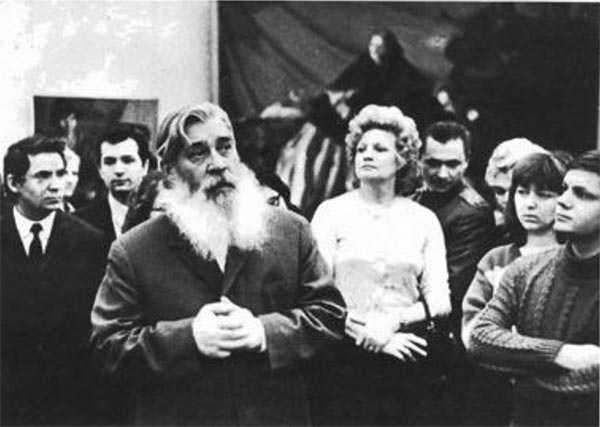
At an art show with the audience. Moscow, the late 1970s
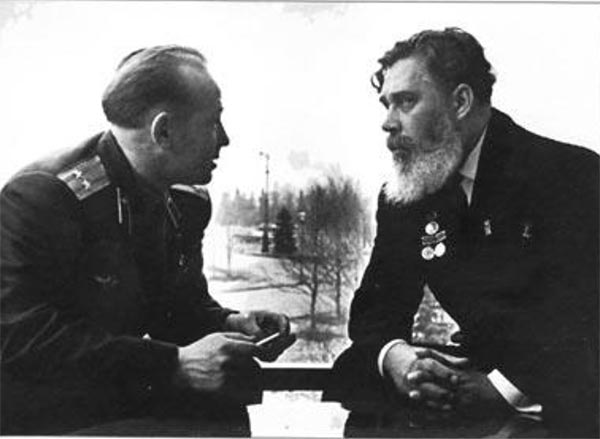
A.P. Kibalnikov with astronaut A.A. Leonov. The late 1960s
I was lucky enough to meet a lot of outstanding figures of culture and art like artists, musicians, actors, and writers... They included one Great figure that my creative biography started with.
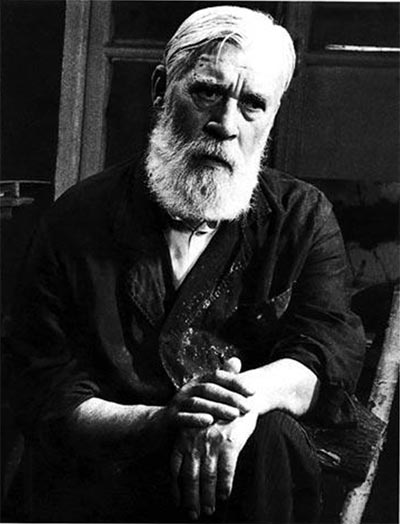
А.Р. Kibalnikov. The 1980s
At the age of twelve I first set foot in Aleksandr Kibalnikov's workshop in Verkhnyaya Maslovka. «Let's go and show your pictures to a People's Artist. He Is the author to the monument to Mayakovsky in Moscow», told me my father.
«Oh! - Oh...» I thought anticipating the worst. Terrified. I stood in the doorway of the great master's workshop. His assistant opened the door letting us in. So we came in.
«Aleksandr Pavlovich», said the assistant, «a girl and her dad came to see you».
«А girl?!» a bearded old man peeped out of his workshop with his grey curls falling down on his forehead. «I'll be there in a minute». We were seen to a small reception room, if I may say so, with simple or even almost no furniture...
Immediately the bearded old man with a gown on came into the room. He had clay, ploster, and modeling clay all over him. So we got acquainted. He looked at us attentively listening to our story. Then all of a sudden he said: «Put your pictures here»!
Kibalnikov looked at the pictures intently coming up and taking one, then - another...
«What's this?» he asked pointing at a pile of sheets in my hands.
«They all would not fit». I replied.
He raised his eyebrow saying:
«Let's do it in portions. This one is good. Could you please give it to me? And that one is good too. Put the other ones».
And I put more and more pictures.
Aleksandr Pavlovich gave me the moon eyed look saying:
«You have so many pictures! How long did it take you to create them»?
I answered. He hemmed:
«So you like drawing, right»?
Like any other teenager I frowned murmuring something.
He laughed saying:
«You frown, so you do not want to say, right? Good for youl Never tell anyone! You cannot say things like that to anyone»...
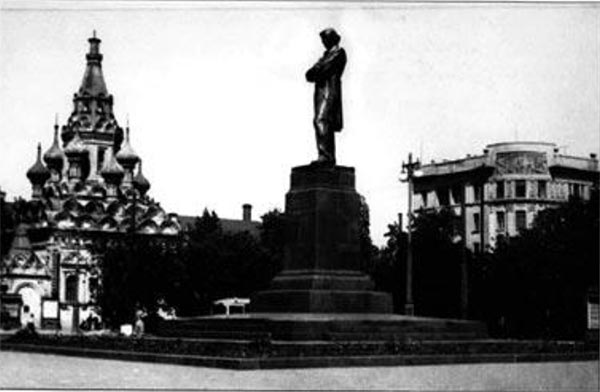
The monument to N.G. Chernyshevsky in Saratov. 1953. Bronze
My parents and I often came to see the Kibalnikovs in their apartment in a skyscraper at Kotelnicheskaya Naberezhnaya (Kotelnicheskaya Quay). Their house was always open to friends and was widely known for its owners' generosity and hospitality. Everybody including astronauts, singers, artists, and film directors enjoyed atmosphere of freedom and cheerfulness at their place.
I remember their spacious living-room and huge window offering a panoramic view of Moscow very well. From the seventeenth storey it all seemed so toylike...
In front of the window there was a high rubber plant with large half-round leaves and a bust of Mayakovsky under the rubber plant. I remember the swift rotation of the poet's head and eyebrows plunged into a frown...
And at the head of the table sat the host finding himself right in front of Mayakovsky. With his hair completely grey, he sat frowning a bit for some reason...
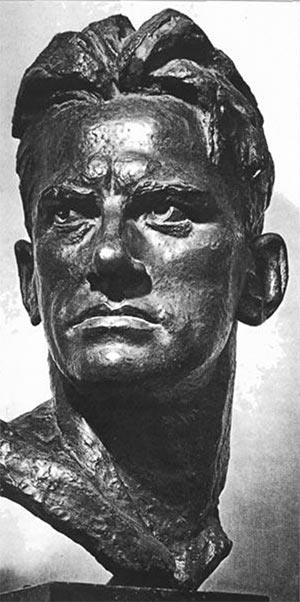
V.V. Mayakovsky's portrait 1956.
Bronze. V.A. Kibalnikova's meeting
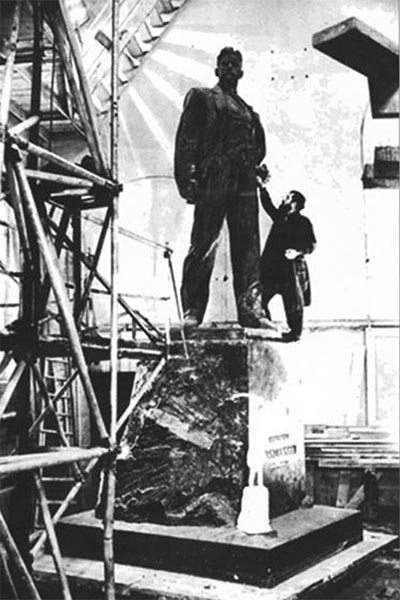
Working over a monument
to V.V. Mayakovsky. 1956
So nothing but lines from another poet's verse occur to you:
I don't pity, don't colt, don't cry.
All will be gone. like haze from the white apple trees.
Seized by the god of withering.
I will never be young again...
Smoke is everywhere... smoke of the Fatherland. Smoke o' villages burning near Smolensk, smoke of Stalingrad Battle, and smoke of permanent posts of Brest...
I first saw «To the Brest Fortress Defenders» Memorial in the late 1980s.
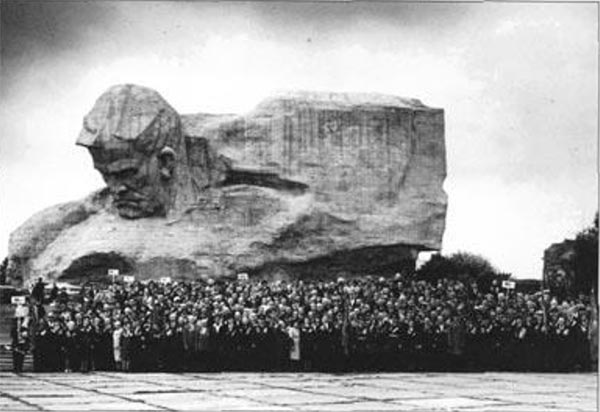
The memorial ensemble «Tо the Brest fortress Defenders». 1970
Great Patriotic War veterans at «The Soldier» sculpture in 1971. Concrete. (350 m high)
Everyone that has been there always remembers the austere profile of a Russian soldier sinking in the fortress's ruins breast deep... to emerge from them for good. A few steps aside from it, at the bank of the Bug River «Thirst» Monument towers featuring a soldier who sneaked to get water under fascists' fire. The idea of the monument appeared in the nick before submitting the project - it had not been in the pans. The approving commission of party members made wry mouths wondering what image of a defending warrior the author tried to communicate.
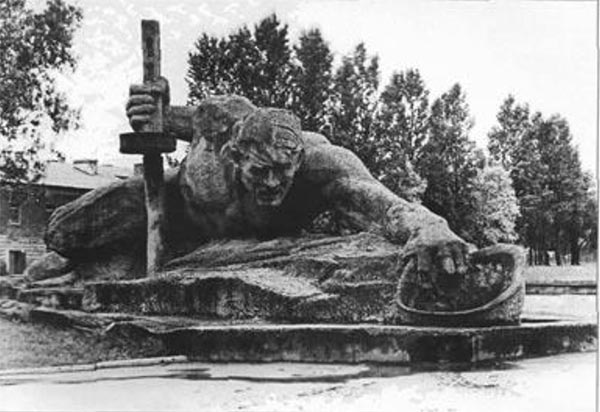
The memorial ensemble «То the Brest Fortress Defenders». 1970. «Thirst» Sculpture. 1970. Concrete
The artist replied he tried to portrait people deserving the right for memory they owe to millions killed in the war.
When the memorial of the Brest Fortress was unveiled, common people brought some water pouring it Into the steel pot of the soldier crawling to the Bug River. From then onwards water has always been there...
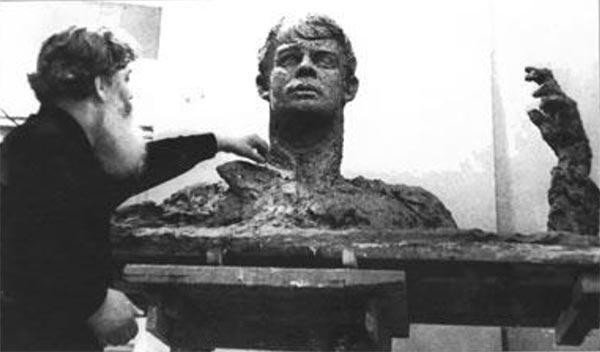
Working over design of a monument to Sergey Yesenin in Ryazan. The 1970s
Next Aleksandr Pavlovich created a monument to Sergey Yesenin in Ryazan. I do not really know, whether fine art experts noticed it or not. but to me it appears to be obvious continuation of Brest’s plastic idea with Russian poet emerging from the earth to remain in it forever just like the giant soldier of the Brest Fortress.
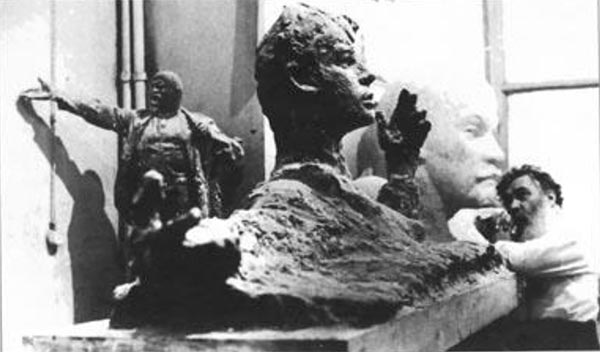
Working over design of a monument to Sergey Yesenin in Ryazan. The 1970s
The poet spread his arms like a bird spreads its wings when it is ready to take off. But unfortunately earth won't let him go. Even plastic interpretation of the very earth the monument features reminds me of the ruins of permanent posts in Brest. The monument to Yesenin is so stirring and bitter, that I still do not dare to accept it. So a poem by an absolutely different poet dawns upon me:
All of you on poet's heart butterfly.
Will pile up so dirty...
Aleksandr Kibalnikov was definitely right. It always happens to poets in Russia...
It seems the artist gave a clue to the audience pointing at the salt of the Fatherland's earth showing a defending warrior and poet going to doom for honour...
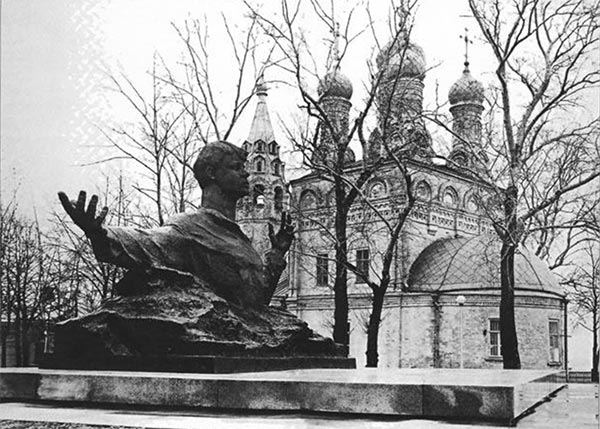
Monument to Sergey Yesenin. Ryazan. 1975. Bronze
My favourite monument by Aleksandr Pavlovich Kibalnikov seems different at first glance. It is quiet and subtle. Once one of my sculptor friends even said it was «absolutely unexpressive». I nearly fell foul of him hearing the words. The only reason why I did not do it was because he was an old friend of mine.
I mean the monument to Pavel Mikhailovich Tretyakov in Moscow. It took years for then officials to let it be mounted at its righteous place, as it was considered all-fired gall to erect a monument to a capitalist...
Only in 1980 this creation by Aleksandr Kibalnikov was unveiled.
«This is the salt of the earth», the master claimed openly now.
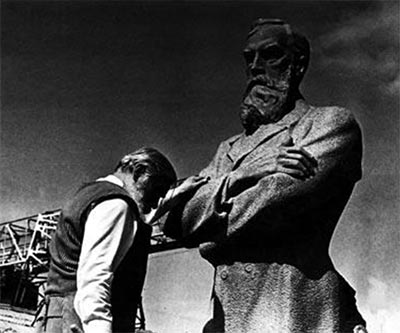
Before unveiling the monument to P.M. Tretyakov in Moscow. 1980
With almost no base, the founder of the Tretyakov Galleiy stands humbly in front of it. Unremarkable and indestructible like a cliff, he emerges from stone sinking in it for good. His right knee that is almost unseen implies he can take a step and leave, but his arms folded firmly across his chest leave no doubt that he won't. He won't move, he won't go to a rally, he won't demand or cry, he won't even ask anything - he knows all... And he won't eat pineapples, since he is quite happy with buckwheat that he ate all his life... And he will soend his fortune on Russian Art. rather than on an English football club.
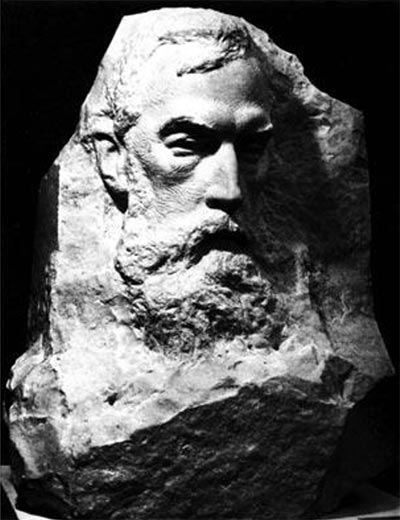
The portrait of P.M. Tretyakov. 1961. Marble. The State Tretyakov Gallery collection
He does not even seem to be ready for a feat: he lived his life quietly. He never took part in a duel, he never commanded forces, he never hung himself in a hotel... and he was never hung, he never died of thirst...
The monument to Tretyakov features minimum clothes folds, minimum motion and mimics, and minimum blows against stone with a tool. Instead it features maximum content: Tretyakov is ready to die for honour and dignity of Russian Culture.
So behind his narrow back I see hundreds... or thousands... or even hundreds of thousands of people including artists, musicians, poets, and librarians, our museum keepers, and our history keepers.
Pavel Mikhailovich Tretyakov seems to frown a little bit just as Aleksandr Pavlovich Kibalnikov in almost all his pictures. But a frown Is better than pointless fun in hard times. Moving eyebrows always reveal thoughts and feelings...
On August 22. 2012 1 will come to visit you, Aleksandr Pavlovich, in Novodevichye Graveyard to celebrate your 100th anniversary. And just like you I will frown a bit. Days have passed, years have fled. Something has been done. A lot Is still to be done. Some remember. Others have forgotten naturally. And still:
If stars are lit
It means - there is someone who needs it.
It means - someone wants them to be.
Margarita Syurina,
painter and curator ot an art show dedicated to the 100th anniversary of A.P. Kibalnikov in Moscow Academic Art School of the Russian Academy of Arts
In November 2012 the Museum and Exhibition Complex of Moscow Academic Art School of the Russian Academy of Arts will host an art show dedicated to the 100th anniversary of Aleksandr Pavlovich Kibalnikov, People’s Artist of the USSR, Academician, and State Prizes Laureate.
We suggest that Russian State Museums should takepartin thejubi- leeexhibitiondedicatedtothe 100th anniversary of A. P. Kibalnikov - his gorgeous chamber sculptural portraits from museum collections will be a jewel of the exposition in Moscow Academic Art School.
We suggest that art and culture figures who knew Aleksandr Pavlovich personally, worked with him, or studied under his guidance should take part in A.P. Kibalnikov’s jubilee exhibition in Moscow Academic Art School.
Several contemporary Russian artists have already confirmed their participation in the jubilee exhibition dedicated to the 100th anniversary of A.P. Kibalnikov. They will present their new sculptures and paintings dedicated to the outstanding master.
And we suggest that all people of art from Saratov and Volgograd, Moscow dwellers, and all Russian artists should celebrate the 100th anniversary of Aleksandr Pavlovich Kibalnikov, whose brilliant creations we all can enjoy today, by making pieces of art dedicated to the great Artist and the main theme of his life - dignified Russian people.
To take part In A.P. Kibalnikov's Jubilee art show In Moscow Academic Art School of the Russion Academy of Arts please
contact +7 916 246 24 32
All contact details are available at https://margaritasurina.ru/
